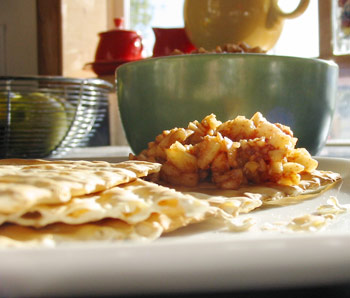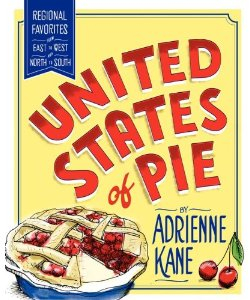
In honor of Passover, a holiday that has always been more about the food shared than it has been about religious significance to me– I give you Haroset, or Charoses as it may be. Why the difference in spelling, thus the difference in pronunciation? Well its a matter of both transliteration and place. If you are a Jew descending from Western Europe or Africa– a Sephardic Jew, you would say Haroset. If you are an Eastern European Jew, an Ashkenazic Jew, you would soften the T sounds to an S, and the H would be pronounced with a CHA sound, sort of like you were clearing your throat. Whew, its difficult to spell all of those guttural sounds.
I remember the Seders of my youth. Sitting through what seemed an interminable ceremony, the nerves over reciting the Four Questions, ending in the culmination of the Seder, and the sweet, cinnamony flavor of the Charoses piled atop a brittle piece of Matzah. For those that have never been to a Seder, and have never tried Charoses, it is a simple amalgamation of a few ingredients. Uncooked, the item that I would most equate it to is a chutney of sorts.
Sephardic and Ashkenazic Harosets differ in ingredients. The Sephardic, favoring sultry climates, with the prominence of dried fruit such as dates and apricots, combined with nuts, are chopped and macerated. The Ashkenazic having just apples, walnuts, cinnamon, honey, and lemon zest, all brought together with a touch of wine (Manischewitz of course). Very simple, not the prettiest of dishes, but Ashkenazic Charoses was my favorite item on the Seder plate.
A few simple rules must be abided by when making Charoses. Even with the advent of kitchen gadgets such as the Cuisinart, the apples must be chopped by hand. This adds to the rough and tumble texture of the apple bits, some tiny, so they practically slip down one’s throat, others larger, requiring a careful chew or two before swallowing. A mixture of apples is best when selecting for Charoses. Sweet-tart, like Fujis or Pink Ladies are perfect when it comes to flavor; but similar to when one is making a pie, a Grannysmith or Pippin, thrown in for good measure, adds a tartness and body that can’t be beat.
Like Matzo Balls, each Jewish person that you meet will swear they have the ideal recipe. It’s their grandmother’s, sister’s, cousin’s by marriage, third child, right? That may be so, but I have a damn good recipe as well. It comes from my mother (a convert–GASP!), who got the recipe from an old spiral bound community cookbook from Modesto, CA.
This recipe is adapted a bit from the original recipe which is by Vi Wernick circa 1974. The recipe comes from one of those spiral bound community cookbooks; a true through-back from the not so distant past. I usually double the recipe. Thanks Vi.
Passover Charoses
1 cup finely chopped apple, a mix of sweet and tart
1/4 cup chopped walnuts
2 teaspoons honey
grated zest of 1/2 lemon
1 teaspoon cinnamon
2 tablespoon red wine (approximately)
Mix all of the ingredients. Add enough wine to bind the mixture. Charoses can be served immediately, or hold in the refrigerator until ready to use.


